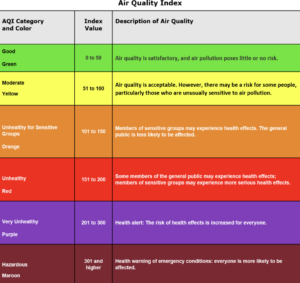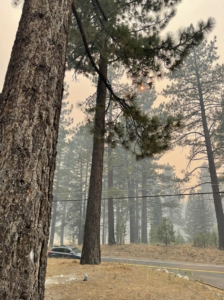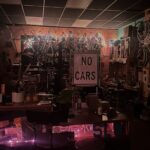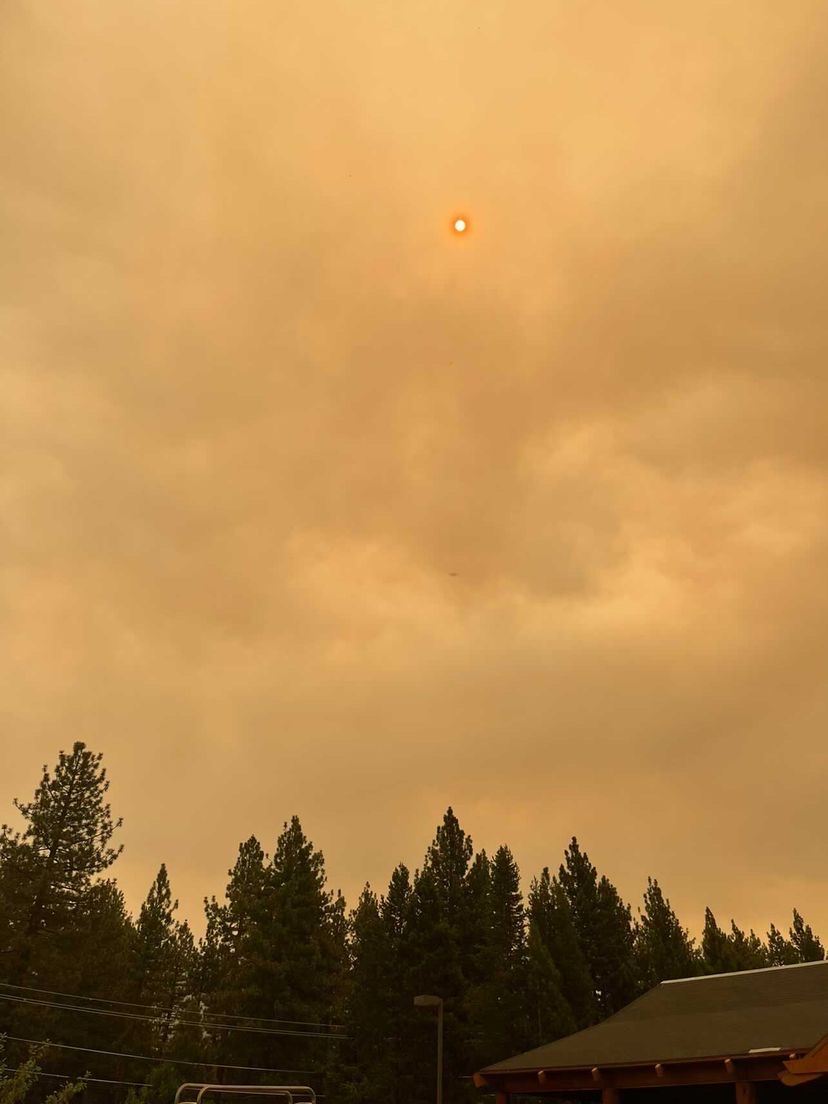As sunny summer weather shifts into yet another California fire season, it is difficult to tell whether the wall of grey overcoming San Francisco arises from the infamous fog or something potentially much more dangerous: unhealthy air particles from the Caldor and Dixie fires.

photo courtesy of Talia Stryker
Air Quality Index (AQI) is a scale from 0-500 that measures four major air pollutants in order to determine how healthy and breathable the air is. AirNow, a branch of the U.S. Environmental Protection Agency (EPA), explains that monitors around the country record concentrations of ground level ozone, particle pollution, carbon monoxide and sulfur dioxide. Each of these measurements are then converted into separate AQI values, and the highest of the four is reported as the current AQI for that area.
The scale, developed by the EPA, divides the AQI into separate color groups in order to warn residents if the air quality may be harmful to their health.

chart courtesy of the EPA
Green and yellow are considered breathable, whereas purple and maroon signal extremely high risks for those in the area. Between the beginning of the Dixie fire in July and now, the Bay Area has teetered between green and orange, spending the majority of the time in the yellow “moderate” category.
Although the Bay Area’s air quality is not as hazardous as areas closer to this year’s wildfires, the prevalence of poor air quality days raises the question: does breathing consistently below average air present a health concern?
“There is no such thing as a poor air quality day that doesn’t present harm to all of us,” said Dr. Tom Dailey, previously chair of the hearing board of the Bay Area Air Quality Management District (BAAQMD). Dailey now works in Pulmonary and Critical Care Medicine at Kaiser Permanente Santa Clara.
“If an AQI of 300 is equivalent to smoking a pack of cigarettes a day, then one of these ‘unhealthy for sensitive groups’ days might be the equivalent to smoking a half a pack of cigarettes a day,” Dailey described.
He explained that fire smoke contains very small particulate matter that, when inhaled, can embed in the tissues of the lungs, as well as penetrate through them. This can cause irritation and inflammation. During poor air quality days, there are significant rises in asthma cases as well as emphysema chronic obstructive pulmonary disease (COPD) exacerbations.
Dailey recommended sealing windows as well as putting air conditioning systems on “recirculate” in order to avoid pulling smoke into an indoor environment. Air purifiers are another way to make the air indoors more breathable.
A study by the National Center for Biotechnology Information determined that air purifiers can effectively remove unhealthy air particles from a room. Air purifiers can be extremely useful to alleviate the effects of unhealthy air quality, but they are far from accessible to everyone. A quick internet search can determine that the cost of a single air purifier, useful for a single room, tends to range from $300-$500.
Felix Fein ’22, Alex Mader ’22 and Kyan Shlipak ’22 recognized the need for air purification in schools that may not have access to these systems.
“Coming out of the pandemic, schools are told to just leave windows open to mitigate the spread of the virus, but they’ve been hit with wildfire smoke days. The smoke just pours in and they have no air purifiers whatsoever,” Shlipak said.
Fein, Mader and Shlipak founded Particulates Matter, a non-profit aiming to provide youth education, N95 masks and air purification systems for schools in the Southeast sector of San Francisco. Particulates Matter builds purification systems by attaching MERV-14 filters to high-efficiency box fans, filtering 99% of pollutants, like diesel particulate matter and wildfire smoke. Air purifiers can also be helpful in reducing the spread of COVID-19 by circulating the air.
They received a grant from the Youth Leadership Institute’s BLING program that has allowed them to build almost 150 air purifiers for more than 10 schools.
“Lick has offered even more funding for purifier supplies, and we will either partner with new schools or work with our current partners to ask families if they want to bring them home,” Fein explained.
Lick-Wilmerding High School’s new air filtration system has influenced the school’s plans in the event that the Bay Area’s AQI spikes. The school decided that students will continue to attend classes on campus if the air quality enters the red zone and move to remote learning if it enters purple. However, the campus will still be open for students who would feel more comfortable being in a space with an air filtration system such as that of LWHS.
Head of School Eric Temple notes that the pandemic’s wake has left LWHS with the ability to continue school over Zoom in the event that the AQI rises above 200. “In the past we’ve canceled school, but now we know we can stay open and hold classes online,” he said.
Noelle Winn ’23 questions why the discussion about air quality has seemed to increase dramatically over the last couple of years. “When I was younger, I never used to check the AQI,” she said, “but recently I hear about it a lot more often.”
Erin DeMerritt, a spokesperson for the BAAQMD, explains why: “We’ve kind of seen an uptick in poor air quality days over the past several years and that’s definitely been driven by wildfires. Those wildfires are being driven by climate change, causing more extreme weather that continues to supercharge wildfires.”
Climate change intensifies the factors that create the perfect fire conditions, according to National Geographic. Increasing temperatures and droughts cause hot air to soak up moisture from plants, soil, lakes and rivers, creating the ideal tinder for a wildfire.
To escape the Caldor fire, former Bay Area resident Talia Stryker recently evacuated from her residence in South Lake Tahoe to San Francisco.

photo courtesy of Talia Stryker
The AQI in South Lake Tahoe at the time Stryker evacuated was reaching 800, an inconceivable amount on a scale that maxes out as hazardous at 500. “The further we drove out of the Tahoe area,” Stryker described, “the clearer the sky was.”
Although global warming and wildfires seem to dramatically increase the AQI, local residents also play a huge role in impacting the air they breathe. Two of the major air pollutants traced by AQI monitors, ozone and particle pollution, are greatly increased by easily avoidable residential activity. During the wintertime and wildfire months, residential wood burning is the largest source of air pollution; it produces more than a third of all fine particle pollution in the Bay Area.
DeMerritt noted that the number one source of air pollution in the Bay Area is transportation related, mostly from cars and trucks. As a community effort, the BAAQMD created Spare the Air in 1991, alerting Bay Area residents on unhealthy air quality days and encouraging them to help reduce air pollution. Specifically, they encourage people to drive less and take public transportation on Spare the Air alert days, as driving has a direct effect on the AQI.
A large quantity of poor air quality originates from residential activity. Spare the Air reminds people in the Bay Area that they should limit their individual contributions to air pollution — especially on days when the AQI is already so high, such as during an active wildfire.
Bay Area residents can keep themselves safe short term by consistently checking the AQI of their area. Staying inside when the AQI is high and helping to reduce the unnecessary air pollution that comes from cars and woodburning can benefit the entire community.
Global warming feeds air pollution which, in turn, continues to feed climate change. “This is an ongoing issue,” Dailey said. “I think the hope that this will go away or that we are in the clear is probably unrealistic.”
Dailey suggests that residents should stay indoors when the AQI is high, but spend green days taking advantage of the good air by spending time outside, exercising and preparing themselves to mitigate the effects of poor air quality days in the future.






